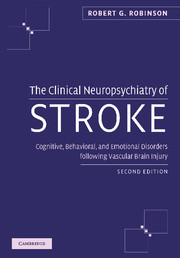 The Clinical Neuropsychiatry of Stroke
The Clinical Neuropsychiatry of Stroke Book contents
- Frontmatter
- Contents
- Preface
- Part I Introduction
- Part II Poststroke depression
- 5 Diagnosis of depression
- 6 Prevalence of depressive disorders
- 7 Phenomenology and specificity of depressive symptoms
- 8 Natural course of depression
- 9 Delayed-onset depression
- 10 Relationship to lesion location
- 11 Relationship of depression to cerebral dominance and structural asymmetries
- 12 Relationship of depression to bilateral hemisphere brain injury
- 13 Relationship of depression to physical impairment
- 14 Relationship to cognitive impairment and treatment
- 15 Relationship of aphasia to depression
- 16 Relationship of depression to social functioning
- 17 Relationship to premorbid risk factors
- 18 Mortality and treatment
- 19 Suicidal thoughts and plans
- 20 Biological markers
- 21 Mechanisms of poststroke depression
- 22 Treatment of poststroke depression
- 23 Prevention of poststroke depression
- Part III Poststroke mania
- Part IV Poststroke anxiety disorders
- Part V Other poststroke disorders
- Index
10 - Relationship to lesion location
from Part II - Poststroke depression
Published online by Cambridge University Press: 01 October 2009
- Frontmatter
- Contents
- Preface
- Part I Introduction
- Part II Poststroke depression
- 5 Diagnosis of depression
- 6 Prevalence of depressive disorders
- 7 Phenomenology and specificity of depressive symptoms
- 8 Natural course of depression
- 9 Delayed-onset depression
- 10 Relationship to lesion location
- 11 Relationship of depression to cerebral dominance and structural asymmetries
- 12 Relationship of depression to bilateral hemisphere brain injury
- 13 Relationship of depression to physical impairment
- 14 Relationship to cognitive impairment and treatment
- 15 Relationship of aphasia to depression
- 16 Relationship of depression to social functioning
- 17 Relationship to premorbid risk factors
- 18 Mortality and treatment
- 19 Suicidal thoughts and plans
- 20 Biological markers
- 21 Mechanisms of poststroke depression
- 22 Treatment of poststroke depression
- 23 Prevention of poststroke depression
- Part III Poststroke mania
- Part IV Poststroke anxiety disorders
- Part V Other poststroke disorders
- Index
Summary
Background
Since the 1860s when Broca described the clinical–pathological correlation between verbal impairment and left hemisphere stroke, neurologists have been searching for the anatomical substrates of mental as well as physical function. Even today, behavioral neurologists study the anatomical substrates of emotion (Damasio and Geschwind 1985). Some clinicians, however, have found it difficult to believe that all poststroke depressions may not be a psychological response to impairment. Thus, a controversy about the relationship between depressive disorder and lesion location has continued since the first publication of this text. In fact, Carson et al. (2000) reported a meta-analysis of all studies of poststroke depression that examined the association between depression (as determined by diagnostic criteria or rating scale cut-off scores) and lesion location. They concluded that “this systematic review offered no support for the hypothesis that the risk of depression after stroke is affected by the location of the brain lesion.” Moreover, Gainotti et al. (1999) stated that our work had been criticized on “factual grounds,” because several authors “using verbal and non-verbal measures of depressed mood failed to observe a significant relationship between the severity of poststroke depression and lesion location in the frontal lobe.” Gainotti et al., however, failed to cite the numerous studies that did find a significant relationship between depression and frontal lobe lesions.
- Type
- Chapter
- Information
- The Clinical Neuropsychiatry of StrokeCognitive, Behavioral and Emotional Disorders following Vascular Brain Injury, pp. 87 - 110Publisher: Cambridge University PressPrint publication year: 2006


